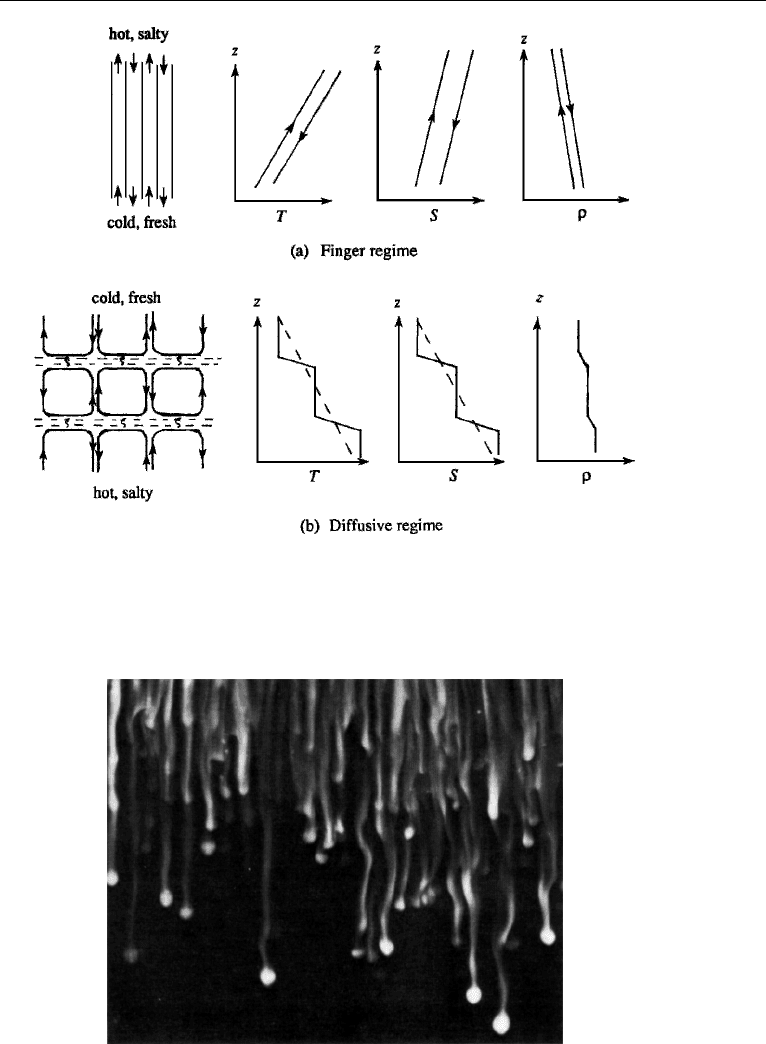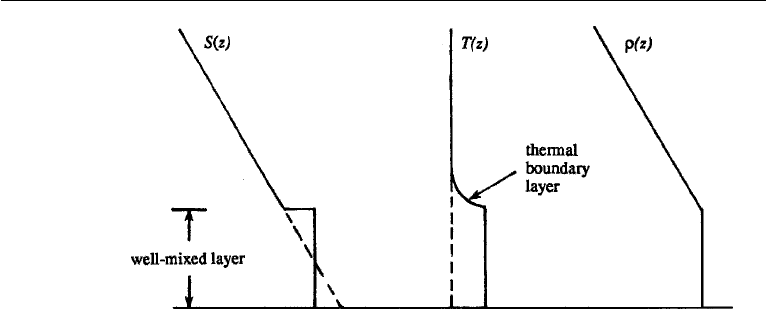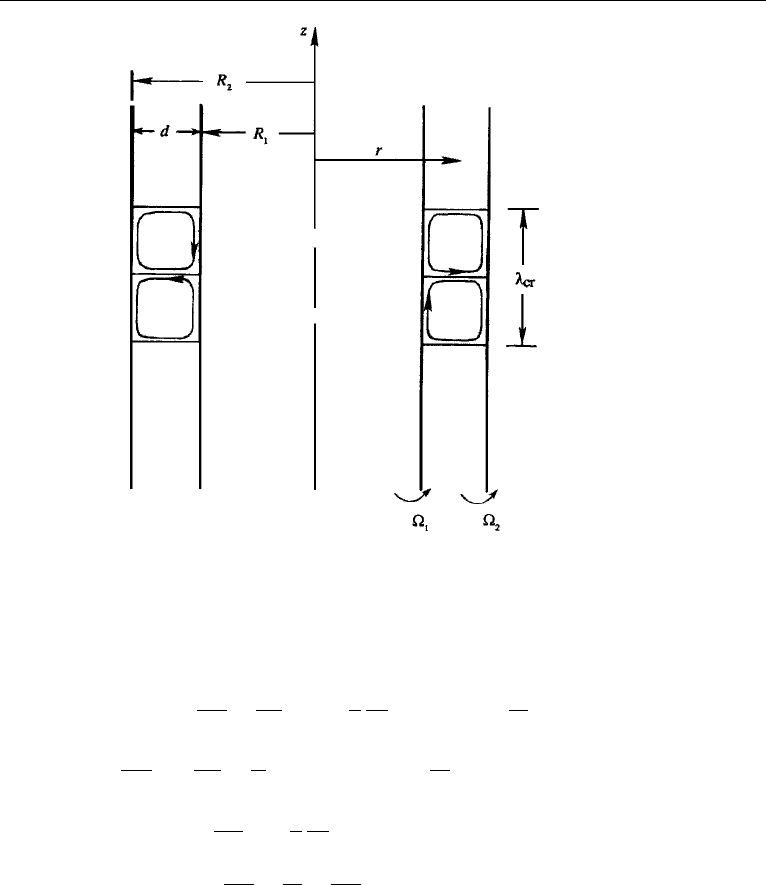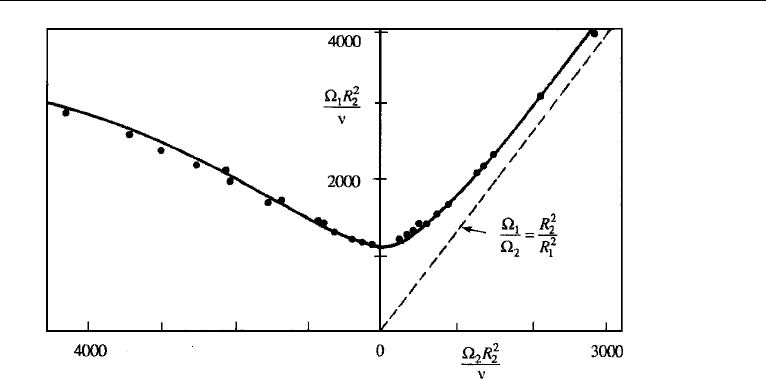Cohen I.M., Kundu P.K. Fluid Mechanics
Подождите немного. Документ загружается.


482 Instability
property that the viscosity of a liquid decreases with temperature, whereas that of
a gas increases with temperature. The rising fluid loses heat by thermal conduction
at the top wall, travels horizontally, and then sinks. For a steady cellular pattern,
the continuous generation of kinetic energy is balanced by viscous dissipation. The
generation of kinetic energy is maintained by continuous release of potential energy
due to heating at the bottom and cooling at the top.
4. Double-Diffusive Instability
An interesting instability results when the density of the fluid depends on two oppos-
ing gradients. The possibility of this phenomenon was first suggested by Stommel
et al. (1956), but the dynamics of the process was first explained by Stern (1960).
Turner (1973), and review articles by Huppert and Turner (1981), and Turner (1985)
discuss the dynamics of this phenomenon and its applications to various fields such
as astrophysics, engineering, and geology. Historically, the phenomenon was first
suggested with oceanic application in mind, and this is how we shall present it. For
sea water the density depends on the temperature
˜
T and salt content ˜s (kilograms of
salt per kilograms of water), so that the density is given by
˜ρ = ρ
0
[1 − α(
˜
T − T
0
) + β(˜s − s
0
)],
where the value of α determines how fast the density decreases with temperature, and
the value of β determines how fast the density increases with salinity. As defined here,
both α and β are positive. The key factor in this instability is that the diffusivity κ
s
of
salt in water is only 1% of the thermal diffusivity κ. Such a system can be unstable even
when the density decreases upwards. By means of the instability, the flow releases
the potential energy of the component that is “heavy at the top.” Therefore, the effect
of diffusion in such a system can be to destabilize a stable density gradient. This is in
contrast to a medium containing a single diffusing component, for which the analysis
of the preceding section shows that the effect of diffusion is to stabilize the system
even when it is heavy at the top.
Finger Instability
Consider the two situations of Figure 12.7, both of which can be unstable although
each is stably stratified in density (d ¯ρ/dz < 0). Consider first the case of hot and
salty water lying over cold and fresh water (Figure 12.7a), that is, when the system
is top heavy in salt. In this case both d
¯
T/dz and dS/dz are positive, and we can
arrange the composition of water such that the density decreases upward. Because
κ
s
κ, a displaced particle would be near thermal equilibrium with the surroundings,
but would exchange negligible salt. A rising particle therefore would be constantly
lighter than the surroundings because of the salinity deficit, and would continue to
rise. A parcel displaced downward would similarly continue to plunge downward.
The basic state shown in Figure 12.7a is therefore unstable. Laboratory observations
show that the instability in this case appears in the form of a forest of long narrow
convective cells, called salt fingers (Figure 12.8). Shadowgraph images in the deep
ocean have confirmed their existence in nature.

4. Double-Diffusive Instability 483
Figure 12.7 Two kinds of double-diffusive instabilities. (a) Finger instability, showing up- and downgoing
salt fingers and their temperature, salinity, and density. Arrows indicate direction of motion. (b) Oscillating
instability, finally resulting in a series of convecting layers separated by “diffusive” interfaces. Across these
interfaces T and S vary sharply, but heat is transported much faster than salt.
Figure 12.8 Salt fingers, produced by pouring salt solution on top of a stable temperature gradient. Flow
visualization by fluorescent dye and a horizontal beam of light. J. Turner, Naturwissenschaften 72: 70–75,
1985 and reprinted with the permission of Springer-Verlag GmbH & Co.

484 Instability
We can derive a criterion for instability by generalizing our analysis of the B´enard
convection so as to include salt diffusion. Assume a layer of depth d confined between
stress-free boundaries maintained at constant temperature and constant salinity. If we
repeat the derivation of the perturbation equations for the normal modes of the system,
the equations that replace equation (12.25) are found to be
(D
2
− K
2
)
ˆ
T =−W,
κ
s
κ
(D
2
− K
2
)ˆs =−W,
(D
2
− K
2
)
2
W =−Ra K
2
ˆ
T + Rs
K
2
ˆs,
(12.31)
where ˆs(z) is the complex amplitude of the salinity perturbation, and we have defined
Ra ≡
gαd
4
(d
¯
T/dz)
νκ
,
and
Rs
≡
gβd
4
(dS/dz)
νκ
.
Note that κ (and not κ
s
) appears in the definition of Rs
. In contrast to equation (12.31),
a positive sign appeared in equation (12.25) in front of Ra because in the preceding
section Ra was defined to be positive for a top-heavy situation.
It is seen from the first two of equations (12.31) that the equations for
ˆ
T and
ˆsκ
s
/κ are the same. The boundary conditions are also the same for these variables:
ˆ
T =
κ
s
ˆs
κ
= 0atz =±
1
2
.
It follows that we must have
ˆ
T =ˆsκ
s
/κ everywhere. Equations (12.31) therefore
become
(D
2
− K
2
)
ˆ
T =−W,
(D
2
− K
2
)
2
W = (Rs − Ra)K
2
ˆ
T,
where
Rs ≡
Rs
κ
κ
s
=
gβd
4
(dS/dz)
νκ
s
.
The preceding set is now identical to the set (12.25) for the B´enard convection, with
(Rs − Ra) replacing Ra. For stress-free boundaries, solution of the preceding section
shows that the critical value is
Rs − Ra =
27
4
π
4
= 657,

4. Double-Diffusive Instability 485
which can be written as
gd
4
ν
β
κ
s
dS
dz
−
α
κ
d
¯
T
dz
= 657. (12.32)
Even if α(d
¯
T/dz)−β(dS/dz) > 0 (i.e., ¯ρ decreases upward), the condition (12.32)
can be quite easily satisfied because κ
s
is much smaller than κ. The flow can therefore
be made unstable simply by ensuring that the factor within []is positive and making
d large enough.
The analysis predicts that the lateral width of the cell is of the order of d, but such
wide cells are not observed at supercritical stages when (Rs − Ra) far exceeds 657.
Instead, long thin salt fingers are observed, as shown in Figure 12.8. If the salinity
gradient is large, then experiments as well as calculations show that a deep layer
of salt fingers becomes unstable and breaks down into a series of convective layers,
with fingers confined to the interfaces. Oceanographic observations frequently show
a series of staircase-shaped vertical distributions of salinity and temperature, with a
positive overall dS/dz and d
¯
T/dz; this can indicate salt finger activity.
Oscillating Instability
Consider next the case of cold and fresh water lying over hot and salty water
(Figure 12.7b). In this case both d
¯
T/dzand dS/dz are negative, and we can choose
their values such that the density decreases upwards. Again the system is unstable, but
the dynamics are different. A particle displaced upward loses heat but no salt. Thus it
becomes heavier than the surroundings and buoyancy forces it back toward its initial
position, resulting in an oscillation. However, a stability calculation shows that a less
than perfect heat conduction results in a growing oscillation, although some energy
is dissipated. In this case the growth rate σ is complex, in contrast to the situation of
Figure 12.7a where it is real.
Laboratory experiments show that the initial oscillatory instability does not last
long, and eventually results in the formation of a number of horizontal convecting
layers, as sketched in Figure 12.7b. Consider the situation when a stable salinity gra-
dient in an isothermal fluid is heated from below (Figure 12.9). The initial instability
starts as a growing oscillation near the bottom. As the heating is continued beyond the
initial appearance of the instability, a well-mixed layer develops, capped by a salinity
step, a temperature step, and no density step. The heat flux through this step forms a
thermal boundary layer, as shown in Figure 12.9. As the well-mixed layer grows, the
temperature step across the thermal boundary layer becomes larger. Eventually, the
Rayleigh number across the thermal boundary layer becomes critical, and a second
convecting layer forms on top of the first. The second layer is maintained by heat flux
(and negligible salt flux) across a sharp laminar interface on top of the first layer. This
process continues until a stack of horizontal layers forms one upon another. From
comparison with the B´enard convection, it is clear that inclusion of a stable salinity
gradient has prevented a complete overturning from top to bottom.
The two examples in this section show that in a double-component system in
which the diffusivities for the two components are different, the effect of diffusion

486 Instability
Figure 12.9 Distributions of salinity, temperature, and density, generated by heating a linear salinity
gradient from below.
can be destabilizing, even if the system is judged hydrostatically stable. In contrast,
diffusion is stabilizing in a single-component system, such as the B´enard system. The
two requirements for the double-diffusive instability are that the diffusivities of the
components be different, and that the components make opposite contributions to
the vertical density gradient.
5. Centrifugal Instability: Taylor Problem
In this section we shall consider the instability of a Couette flow between concentric
rotating cylinders, a problem first solved by Taylor in 1923. In many ways the problem
is similar to the B´enard problem, in which there is a potentially unstable arrangement
of an “adverse” temperature gradient. In the Couette flow problem the source of the
instability is the adverse gradient of angular momentum. Whereas convection in a
heated layer is brought about by buoyant forces becoming large enough to overcome
the viscous resistance, the convection in a Couette flow is generated by the centrifugal
forces being able to overcome the viscous forces. We shall first present Rayleigh’s
discovery of an inviscid stability criterion for the problem and then outline Taylor’s
solution of the viscous case. Experiments indicate that the instability initially appears
in the form of axisymmetric disturbances, for which ∂/∂θ = 0. Accordingly, we shall
limit ourselves only to the axisymmetric case.
Rayleigh’s Inviscid Criterion
The problem was first considered by Rayleigh in 1888. Neglecting viscous effects,
he discovered the source of instability for this problem and demonstrated a necessary
and sufficient condition for instability. Let U
θ
(r) be the velocity at any radial dis-
tance. For inviscid flows U
θ
(r) can be any function, but only certain distributions can
be stable. Imagine that two fluid rings of equal masses at radial distances r
1
and r
2
(>r
1
) are interchanged. As the motion is inviscid, Kelvin’s theorem requires that the

5. Centrifugal Instability: Taylor Problem 487
circulation = 2πrU
θ
(proportional to the angular momentum rU
θ
) should remain
constant during the interchange. That is, after the interchange, the fluid at r
2
will have
the circulation (namely,
1
) that it had at r
1
before the interchange. Similarly, the fluid
at r
1
will have the circulation (namely,
2
) that it had at r
2
before the interchange.
The conservation of circulation requires that the kinetic energy E must change during
the interchange. Because E = U
2
θ
/2 =
2
/8π
2
r
2
,wehave
E
final
=
1
8π
2
2
2
r
2
1
+
2
1
r
2
2
,
E
initial
=
1
8π
2
2
1
r
2
1
+
2
2
r
2
2
,
so that the kinetic energy change per unit mass is
E = E
final
− E
initial
=
1
8π
2
(
2
2
−
2
1
)
1
r
2
1
−
1
r
2
2
.
Because r
2
>r
1
, a velocity distribution for which
2
2
>
2
1
would make E pos-
itive, which implies that an external source of energy would be necessary to perform
the interchange of the fluid rings. Under this condition a spontaneous interchange of
the rings is not possible, and the flow is stable. On the other hand, if
2
decreases
with r, then an interchange of rings will result in a release of energy; such a flow is
unstable. It can be shown that in this situation the centrifugal force in the new location
of an outwardly displaced ring is larger than the prevailing (radially inward) pressure
gradient force.
Rayleigh’s criterion can therefore be stated as follows: An inviscid Couette flow
is unstable if
d
2
dr
< 0 (unstable).
The criterion is analogous to the inviscid requirement for static instability in a density
stratified fluid:
d ¯ρ
dz
> 0 (unstable).
Therefore, the “stratification” of angular momentum in a Couette flow is unstable
if it decreases radially outwards. Consider a situation in which the outer cylinder is
held stationary and the inner cylinder is rotated. Then d
2
/dr < 0, and Rayleigh’s
criterion implies that the flow is inviscidly unstable. As in the B´enard problem, how-
ever, merely having a potentially unstable arrangement does not cause instability in
a viscous medium. The inviscid Rayleigh criterion is modified by Taylor’s solution
of the viscous problem, outlined in what follows.

488 Instability
Formulation of the Problem
Using cylindrical polar coordinates (r,θ,z) and assuming axial symmetry, the
equations of motion are
D ˜u
r
Dt
−
˜u
2
θ
r
=−
1
ρ
∂ ˜p
∂r
+ ν
∇
2
˜u
r
−
˜u
r
r
2
,
D ˜u
θ
Dt
+
˜u
r
˜u
θ
r
= ν
∇
2
˜u
θ
−
˜u
θ
r
2
,
D ˜u
z
Dt
=−
1
ρ
∂ ˜p
∂z
+ ν∇
2
˜u
z
,
∂ ˜u
r
∂r
+
˜u
r
r
+
∂ ˜u
z
∂z
= 0,
(12.33)
where
D
Dt
≡
∂
∂t
+˜u
r
∂
∂r
+˜u
z
∂
∂z
,
and
∇
2
≡
∂
2
∂r
2
+
1
r
∂
∂r
+
∂
2
∂z
2
.
We decompose the motion into a background state plus perturbation:
˜
u = U +u,
˜p = P + p.
(12.34)
The background state is given by (see Chapter 9, Section 6)
U
r
= U
z
= 0,U
θ
= V(r),
1
ρ
dP
dr
=
V
2
r
, (12.35)
where
V = Ar +B/r, (12.36)
with constants defined as
A ≡
2
R
2
2
−
1
R
2
1
R
2
2
− R
2
1
,B≡
(
1
−
2
)R
2
1
R
2
2
R
2
2
− R
2
1
.
Here,
1
and
2
are the angular speeds of the inner and outer cylinders, respectively,
and R
1
and R
2
are their radii (Figure 12.10).

5. Centrifugal Instability: Taylor Problem 489
Figure 12.10 Definition sketch of instability in rotating Couette flow.
Substituting equation (12.34) into the equations of motion (12.33), neglecting
nonlinear terms, and subtracting the background state (12.35), we obtain the pertur-
bation equations
∂u
r
∂t
−
2V
r
u
θ
=−
1
ρ
∂p
∂r
+ ν
∇
2
u
r
−
u
r
r
2
,
∂u
θ
∂t
+
dV
dr
+
V
r
u
r
= ν
∇
2
u
θ
−
u
2
θ
r
,
∂u
z
∂t
=−
1
ρ
∂p
∂z
+ ν∇
2
u
z
,
∂u
r
∂r
+
u
r
r
+
∂u
z
∂z
= 0.
(12.37)
As the coefficients in these equations depend only on r, the equations admit solutions
that depend on z and t exponentially. We therefore consider normal mode solutions
of the form
(u
r
,u
θ
,u
z
,p) = ( ˆu
r
, ˆu
θ
, ˆu
z
, ˆp) e
σt+ikz
.
The requirement that the solutions remain bounded as z →±∞implies that the
axial wavenumber k must be real. After substituting the normal modes into (12.37)
and eliminating ˆu
z
and ˆp, we get a coupled system of equations in ˆu
r
and ˆu
θ
. Under the

490 Instability
narrow-gap approximation, for which d = R
2
−R
1
is much smaller than (R
1
+R
2
)/2,
these equations finally become (see Chandrasekhar (1961) for details)
(D
2
− k
2
− σ )(D
2
− k
2
) ˆu
r
= (1 + αx) ˆu
θ
,
(D
2
− k
2
− σ)ˆu
θ
=−Ta k
2
ˆu
r
,
(12.38)
where
α ≡
2
1
− 1,
x ≡
r − R
1
d
,
d ≡ R
2
− R
1
,
D ≡
d
dr
.
We have also defined the Taylor number
Ta ≡ 4
1
R
2
1
−
2
R
2
2
R
2
2
− R
2
1
1
d
4
ν
2
. (12.39)
It is the ratio of the centrifugal force to viscous force, and equals 2(V
1
d/ν)
2
(d/R
1
)
when only the inner cylinder is rotating and the gap is narrow.
The boundary conditions are
ˆu
r
= D ˆu
r
=ˆu
θ
= 0atx = 0, 1. (12.40)
The eigenvalues k at the marginal state are found by setting the real part of σ to zero.
On the basis of experimental evidence, Taylor assumed that the principle of exchange
of stabilities must be valid for this problem, and the marginal states are given by
σ = 0. This was later proven to be true for cylinders rotating in the same directions,
but a general demonstration for all conditions is still lacking.
Discussion of Taylor’s Solution
A solution of the eigenvalue problem (12.38), subject to equation (12.40), was
obtained by Taylor. Figure 12.11 shows the results of his calculations and his own
experimental verification of the analysis. The vertical axis represents the angular
velocity of the inner cylinder (taken positive), and the horizontal axis represents the
angular velocity of the outer cylinder. Cylinders rotating in opposite directions are
represented by a negative
2
. Taylor’s solution of the marginal state is indicated, with
the region above the curve corresponding to instability. Rayleigh’s inviscid criterion is
also indicated by the straight dashed line. It is apparent that the presence of viscosity
can stabilize a flow. Taylor’s viscous solution indicates that the flow remains stable
until a critical Taylor number of
Ta
cr
=
1708
(1/2)
(
1 +
2
/
1
)
, (12.41)

5. Centrifugal Instability: Taylor Problem 491
Figure 12.11 Taylor’s observation and narrow-gap calculation of marginal stability in rotating Couette
flow of water. The ratio of radii is R
2
/R
1
= 1.14. The region above the curve is unstable. The dashed line
represents Rayleigh’s inviscid criterion, with the region to the left of the line representing instability.
is attained. The nondimensional axial wavenumber at the onset of instability is found
to be k
cr
= 3.12, which implies that the wavelength at onset is λ
cr
= 2πd/k
cr
2d.
The height of one cell is therefore nearly equal to d, so that the cross-section of a cell
is nearly a square. In the limit
2
/
1
→ 1, the critical Taylor number is identical
to the critical Rayleigh number for thermal convection discussed in the preceding
section, for which the solution was given by Jeffreys five years later. The agreement
is expected, because in this limit α = 0, and the eigenvalue problem (12.38) reduces
to that of the B´enard problem (12.25). For cylinders rotating in opposite directions
the Rayleigh criterion predicts instability, but the viscous solution can be stable.
Taylor’s analysis of the problem was enormously satisfying, both experimentally
and theoretically. He measured the wavelength at the onset of instability by injecting
dye and obtained an almost exact agreement with his calculations. The observed onset
of instability in the
1
2
-plane (Figure 12.11) was also in remarkable agreement.
This has prompted remarks such as “the closeness of the agreement between his
theoretical and experimental results was without precedent in the history of fluid
mechanics” (Drazin and Reid 1981, p. 105). It even led some people to suggest happily
that the agreement can be regarded as a verification of the underlying Navier–Stokes
equations, which make a host of assumptions including a linearity between stress and
strain rate.
The instability appears in the form of counter-rotating toroidal (or doughnut-
shaped) vortices (Figure 12.12a) called Taylor vortices. The streamlines are in the
form of helixes, with axes wrapping around the annulus, somewhat like the stripes
on a barber’s pole. These vortices themselves become unstable at higher values of
Ta, when they give rise to wavy vortices for which ∂/∂θ = 0 (Figure 12.12b). In
effect, the flow has now attained the next higher mode. The number of waves around
the annulus depends on the Taylor number, and the wave pattern travels around the
